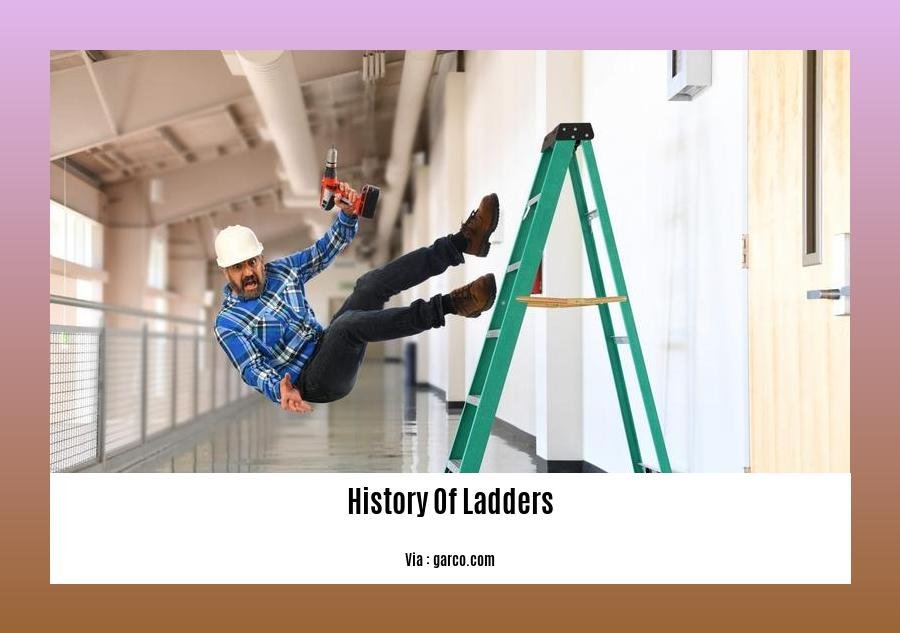Embark on a captivating journey through the annals of history as we delve into the fascinating world of ladders in [- A Comprehensive History of Ladders: Tracing the Evolution of Human Ingenuity]. From their humble beginnings as rudimentary climbing aids to their modern-day applications in diverse industries, this article unveils the remarkable story of how ladders have shaped human endeavors throughout the ages.
Key Takeaways:
- Ladders have been used for over 10,000 years.
- The earliest known image of a ladder is 10,000 years old.
- The origins of ladders can be traced back to ancient Egyptian and Hebrew civilizations.
History Of Ladders

Ladders have been an indispensable tool for humans for millennia, serving various purposes from construction to exploration. Their History Of Ladders is a testament to the ingenuity and adaptability of our species.
Ancient Origins
The earliest evidence of ladders dates back to ancient Egypt and the Levant. Cave paintings found in Spain suggest ladders were already in use around 10,000 years ago. In ancient Egypt, ladders were used in construction, as depicted in tomb paintings from as early as 2500 BC.
Evolution of Ladder Design
Over time, ladder design evolved to meet changing needs. Rope ladders were common in ancient Greece and Rome, providing a portable and lightweight way to scale walls or reach heights. Wooden ladders with rungs or steps became prevalent during the Medieval period.
Modern Ladder Innovations
The Industrial Revolution brought about significant advancements in ladder design. Aluminum ladders, invented in the 19th century, were lighter and stronger than traditional wooden ladders. Fiberglass ladders, introduced in the latter half of the 20th century, offered insulation for electrical work.
Contemporary Applications
Today, ladders remain an essential tool in countless industries, including construction, maintenance, and firefighting. They come in a wide variety of types and sizes, from compact step stools to extendable extension ladders. Ladders continue to play a crucial role in human endeavors, enabling us to reach new heights and access hard-to-reach areas.
Uncover the rich tapestry of Laddsworth’s history by delving into our comprehensive article on the subject. History of Laddsworth
Explore the intriguing narrative of Ladd Addition Portland, a captivating tale of urban development and architectural heritage. History Of Ladd Addition Portland
Ladders in Firefighting
Key Takeways:
- Ladders have been an indispensable tool in firefighting for centuries.
- Tapering and escape ladders in firefighting were introduced in the early 19th century.
- Hook ladders in firefighting gained popularity in the 1970s.
- Hayes’ invention of aerial ladders in firefighting marked a significant milestone in 1868.
Firefighting has always involved reaching great heights, rescuing people from blazing buildings, and accessing hard-to-reach areas. One of the most important tools in a firefighter’s arsenal is the ladder.
Ladders have been used in firefighting for centuries, and their design has evolved considerably over time. In the early days, firefighters used simple wooden ladders in firefighting. These ladders in firefighting were often heavy and difficult to maneuver, but they were the best option available at the time.
A series of innovations revolutionized the design of ladders in firefighting. Tapering ladders in firefighting were introduced in the early 1800s, followed by wheeled escape ladders in firefighting in 1836. Hook ladders in firefighting became widely used in the 1970s, and aerial ladders in firefighting were invented by Hayes in 1868.
Today, ladders in firefighting come in a variety of shapes and sizes. They are made from lightweight materials such as aluminum and fiberglass, and they are designed to be easy to use and maneuver. Ladders in firefighting are an essential tool for firefighters, and they play a vital role in saving lives and property.
URL Sources
- History of Ladders | London Fire Brigade
- Fire Ladder Trucks – How It All Began | Midland Ladders Blog
Ladders in Transportation

Ladders have been indispensable in the realm of transportation, facilitating access to hard-to-reach areas and enabling the movement of people and goods. From ancient chariots to modern airplanes, ladders have played a pivotal role in the evolution of our mobile society.
Early Uses
In ancient times, ladders served as a crucial tool for constructing elevated structures and chariots. Egyptian hieroglyphics depict ladders being used to ascend pyramids, while archaeological evidence suggests that ladders were employed in the construction of Stonehenge. These early ladders were typically made of wood or rope, with simple designs that have endured over centuries.
Maritime Applications
Ladders have also been essential in maritime transportation. In the age of sailing ships, ladders were used to board and disembark vessels, access the rigging, and perform maintenance tasks. Sailors relied on ladders to scale the masts and navigate the intricate network of ropes and sails. As ships grew larger and more complex, ladders became an indispensable tool for navigating the various levels and compartments.
Aerial Ladders
The invention of aerial ladders revolutionized firefighting in the 19th century. These extendable ladders allowed firefighters to reach upper floors of buildings quickly and safely, enabling them to combat blazes more effectively. Aerial ladders have since become a cornerstone of firefighting equipment, saving countless lives and protecting property.
Aircraft Ladders
Ladders have played a vital role in the development of aviation. Early aircraft required ladders to access the cockpit and perform maintenance. As aircraft grew in size and complexity, ladders became an essential tool for servicing engines, wings, and other components. Today, ladders are still used extensively in aircraft maintenance and operations.
Modern Applications
In contemporary transportation, ladders continue to serve a wide range of purposes. They are used in the maintenance and repair of trains, buses, and trucks. Airport ground crews rely on ladders to access aircraft cabins and cargo holds. Construction workers use ladders to reach elevated areas on buildings and infrastructure.
Key Takeaways:
- Ladders have been instrumental in the construction and operation of transportation systems throughout history.
- Ladders have facilitated access to elevated structures, vehicles, and aircraft.
- Aerial ladders have revolutionized firefighting, enabling firefighters to reach higher floors of buildings.
- Modern transportation systems continue to rely heavily on ladders for maintenance and operations.
Relevant URL Sources:
- A History of the World – Object : The ladder
- History of Ladders | London Fire Brigade
Modern Ladder Innovations
Ladders have evolved significantly over the centuries, from their humble beginnings as simple wooden structures to the advanced and versatile tools we use today. Modern Ladder Innovations have pushed the boundaries of ladder technology, introducing new materials and designs that enhance safety, efficiency, and utility.
Key Takeaways:
- Industrialization brought advancements like aluminum, fiberglass, and automatic ladders.
- Ladder design focuses on safety, efficiency, and versatility.
- Modern Ladder Innovations include leanable stepladders and telescoping aluminum single ladders.
- Customization allows for specific requirements and industries.
Materials Revolution
The use of new materials has been a major driver of ladder innovation. Aluminum, for instance, offered a lighter and stronger alternative to wood, making ladders more portable and durable. Fiberglass ladders provided insulation for electrical work, enhancing safety for electricians.
Enhanced Designs
Ladder designs have been refined to improve their functionality and safety. Leanable stepladders, for example, provide a stable platform for working at varying heights, while telescoping aluminum single ladders offer convenient extension and retraction features.
Customization and Specialization
Modern ladders are increasingly customized to meet specific requirements and industries. For instance, ladders designed for firefighters and construction workers feature unique safety features and load capacities. These specialized ladders cater to the unique needs of these professions.
Safety Focus
Safety remains a paramount consideration in ladder design. Non-slip rungs, wide bases for stability, and built-in safety features like auto-locking mechanisms ensure safer ladder use.
Modern ladder innovations have revolutionized how we access elevated areas, enhancing safety, efficiency, and adaptability. From lightweight aluminum single ladders to specialized firefighting ladders, the evolution of ladder technology continues to meet the demands of various industries and applications.
Citations:
- The Evolution of the Ladder – Electrical Contractor Magazine
- When Were Ladders Invented? History of the Ladder – House Grail
FAQ
Q1: When and where was the earliest known ladder discovered?
A1: The oldest known depiction of a ladder, dating back approximately 10,000 years, was found in a cave in Spain.
Q2: How were ladders used in ancient times?
A2: Ladders have been used for various purposes in ancient times, such as reaching high places during construction, accessing elevated areas for religious rituals, and as symbols of status and power.
Q3: What materials were traditionally used to make ladders?
A3: Early ladders were made of wood, bamboo, or rope. Later, metal, such as iron and aluminum, was used for greater strength and durability.
Q4: How have ladders evolved over the centuries?
A4: Ladders have undergone significant evolution, from simple leaning ladders to complex aerial ladders used in firefighting and construction. Modern advancements include the use of lightweight materials, ergonomic designs, and safety features.
Q5: What are the different types of ladders available today?
A5: Today, there are various types of ladders, including step ladders, extension ladders, folding ladders, telescopic ladders, and platform ladders, each designed for specific applications and safety requirements.
- Unlock Water’s Symbolism: A Cross-Cultural Exploration - April 20, 2025
- Identify Black and White Snakes: Venomous or Harmless? - April 20, 2025
- Unlocking Potential: Origins High School’s NYC Story - April 20, 2025















